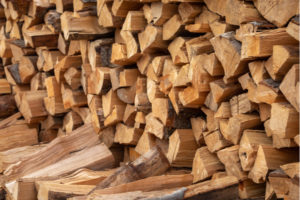
By VDB Photos @ Shutterstock.com
Your Survival Guy just took receipt of two cords of semi-seasoned wood to add to the rotation. If cooler temps in July are any indication of what’s to come, it will be a cold winter. My contacts tell me they’re booked three months out, so work your network now before it’s too late.
At Burly Beaver, JJ explains how long a cord of wood will last:
You can’t help but enjoy the warm glow of a fire. Especially during the winter months. Fire is among mankind’s earliest discoveries, and stoking the embers is just as mesmerizing today.
But, firewood isn’t just a pleasant glow. It’s still an important heating solution for millions of people around the world. If you plan to use wood heating, one of the first questions you have to ask is “how long does a cord of wood last?”. Here’s the short answer:
A full cord of wood typically lasts 6-10 weeks when used as the primary heat source for a home in the winter. Exactly how long wood will last depends on a number of factors, and you should always be prepared with more wood than you expect to need.
6-10 weeks is a reasonable range, but this can vary significantly depending on the type of wood, the size of the space, the quality of the insulation, and more. If you’re preparing for winter, the last thing you want to do is to underestimate the amount of wood you’ll need.
Below we’ll dig into the 8 biggest variables you should consider, and we’ll provide a real-world example from our farm house, to help you better estimate your own firewood needs.
Difference between full cord and face cord
Before going any further, it’s critical that you understand what we mean when we say full cord. The only “standard” government-recognized measure for wood is a cord.
However, most people who sell firewood, are actually selling it by the face cord (also called a rick cord, stove cord or furnace cord).
A face cord is a stack of wood, measuring 4′ high X 8′ long X 16” deep.
A regular (or full) cord is a stack of wood, measuring 4′ high X 8′ long X 4′ deep.
If you missed it, the only difference is that a face cord of wood is 16 inches deep, whereas cord wood is 4 feet deep.
So why the difference? 4 foot long logs don’t fit in most home stoves/furnaces. That’s why people usually buy and sell “face cord” firewood.
It’s absolutely essential to understand this difference, because in total volume of wood, there are 3 face cords in a full cord. This is important for estimating your firewood needs, and when you start looking at firewood pricing.
Alright, with the measurement terminology out of the way, let’s jump into one of the most important factors for firewood heating: hardwood vs. softwood.
8 Questions for Estimating Winter Wood Supply
In our experience, there are 8 main things you should think about, when you’re considering how much firewood you’ll need for heating. In this section we’ll break those down, to help you get started.
1. Is firewood your primary heat source?
There’s obviously a big difference between someone who gets 100% of their home heating from a wood stove, and someone who only uses it for campfires on the weekend.
In the real example below, we’re using firewood as the primary heat source, but if you’re getting 70% of your heat from another source (e.g. natural gas, electric, etc.), then you’re wood consumption will be dramatically reduced.
You may not have thought of this one, but you can also heat your home using processed wood pellets. If you’d like to learn more about wood pellets, and how to find good ones, check-out this post.
2. How big is your home?
It takes a lot more wood to heat a 2,000 square foot farmhouse, than it does to heat an 800 square foot home. The bigger your place, the more wood you’ll need.
You’ve probably thought of this one already, but it will probably help you to compare the square footage of your own home, to the example below (hint: its a 1,900 square foot farm house).
3. Burn all day, or just evenings?
If there’s no-one home all day, then you don’t need a fire running. You can save a lot on wood by only burning in the evening.
However, if you work from home or have a family that is home during the day, then you’ll be heating all day, and will burn more wood as a result.
4. How’s your insulation?
Insulation is a big deal in the world of wood heating. Having good insulation can dramatically reduce the wood you need.
Good insulation also makes things more efficient. If you are buying firewood, this makes things cheaper for you. And either way, it’s better for the environment when you use less energy/wood.
5. How good is your stove?
Not all stoves are created equal. Using a high-efficiency stove will increase heat output, while also decreasing your wood consumption.
If you haven’t bought a stove yet, consider spending extra for a more efficient stove. It could save you money and effort in the long-run, and can even create a more pleasant ambiance.
6. Where do you live?
There’s a few reasons this is important. The big one is temperatures, and the length of winter.
For example, if you live in Texas you’re going to need much less wood than someone in Michigan. Less heat is needed because temperatures are already higher, and winter lasts for fewer months.
Local moisture and levels of rain/snow can make your wood wet, depending on how it’s stored. This affects the quality of the burn and the heat output.
One other thing that is affected by geographic location, is the availability of wood. I mean both the quantity of wood that’s available, and the type of wood. If wood is scarce, it’s even more important to stock up early (or to consider heating alternatives).
And if you can only get softwood where you live, then you’ll need to get more than if you had all hardwood. This brings me to the next point…
7. Hardwood vs softwood firewood?
The type of wood you use for firewood has a big impact on:
- How long the wood lasts
- The heat output of your fire
- The scent/fragrance of your fire
- The weight of your wood
- The ash content of your wood
- The cost of your wood (if purchasing)
Generally speaking, hardwoods are going to be heavier, burn longer, and are better for heating than softwoods.
To illustrate this point, here’s an example: according to the University of Nebraska-Lincoln, a cord of Spruce (a softwood) generates 15.5M BTUs of heat, whereas a cord of Shagbark Hickory (a hardwood) provides 27.5M BTUs. That’s nearly double!
Side note: if you use wood pellets, this trend is actually reversed. I think that’s super interesting. Learn more in this post about wood pellets.
If you’re not sure what type of tree is a softwood, and what’s a hardwood, here’s a list of some of the most common ones in each category:
Common types of hardwoods
- Oak
- Maple
- Hickory
- Locust
- Apple
- Ash
- Walnut
Common types of softwoods
- Pine
- Spruce
- Cedar
- Redwood
- Cypress
- Douglas-fir
8. Is the wood seasoned?
For wood to be “seasoned” is just another way of saying it is thoroughly dried.
You can still burn wood that isn’t fully seasoned, but it will be less effective, because part of the burn energy would be used to dry-out moisture.
In order to minimize the amount of wood you have to buy/gather, you’ll want to make sure it’s well seasoned before you begin burning it. If a tree is freshly cut, it takes 6-12 months to fully season the wood.
If you haven’t done this before, here’s a little bonus tip for how you can season wet or “green” wood in 5 steps:
- Shed or outside – Start your wood-stack outside. You can put it under an open air shed/shelter, or totally outside.
- Elevate – use a firewood rack or recycled pallets to get your wood up off the ground. This allows air to circulate to thoroughly dry the wood.
- Stack for stability – stack the wood only as high as is stable. This depends on how steady the ground is. If it makes you nervous, stop!
- Leave space between rows – each stack should be separated by at least a few inches for air flow. This allows the wood to dry better.
- Cover (optional) – If your wood pile is outside, and you have a cover, or a tarp, you can put it over the wood to drain any rain/snow. Just make sure that it doesn’t totally block airflow from the side of the stack.
Overall it’s pretty simple. Just keep in-mind the importance of stability and air flow. This also assumes that your wood is already split, if you need to split logs check-out our post about gas powered log splitters. For smaller scale splitting, check-out our splitting wedge post.
Alright, that’s it! These are the 8 most important factors that will affect how much wood you need for winter. Now let’s jump to the real example of how many cords our farmhouse burns in winter.
Real Example: How Much Firewood For Winter
Okay, I realize that some of the stuff above has probably seemed a bit theoretical. Now we’re going to make things a bit more real, with the actual numbers from our farm house in northern Indiana. If want to learn more about our story, you can check out the about page.
I grew up in northern Indiana, where we get a pretty cold winter. We get snow every year, and the temperatures go below freezing in January and February (and sometimes in December and March). Winter typically will last from 4-6 months.
Here’s a snapshot of how the house matches up with the 8 questions above.
Indiana Farmhouse: 8 Questions Answered
- Primary heat source = Firewood
- Size of home = 1,900 square feet
- Burn time = Evenings and weekends only
- Insulation = Fair insulation (6 of 10), but it’s an old farmhouse
- Stove quality = High efficiency stove
- Location = Northern Indiana
- Hardwood vs. softwood = Both (mostly hardwood during coldest weeks)
- Seasoned = Yes
In this house, we typically burn about 2 full cords of wood over the winter. In colder years, we’ll burn more, in warmer years a bit less.
This is a case-by-case situation, but in my experience you can expect to use around 1.5-3 full cords of wood in the winter.
As a word of caution, always get more wood than you expect to use. For example, if you think you’ll use 2 cords, round up to 3. It’s way better to have too much wood, than to run out when it’s freezing outside. Plus, if you have too much you can just use it next year.
Related Questions
1. How much does a cord of wood cost?
Let’s talk money. If you’re in the market for some firewood, you’ll want a ballpark price range to help you shop around.
There’s a lot of variables that can affect the cost of firewood, including the following:
- Time of year (prices are higher in winter)
- Scarcity (prices are higher when there’s less wood)
- Region (your location can drive prices up or down)
- Whether the wood is seasoned (some charge more for dry wood)
- Type of wood (hardwoods can cost more than softwoods)
- Additional services charged by the seller (delivery, stacking, etc.)
For a full cord of mixed firewood, a common range is $150-$250.
This means for a face cord, you’re usually looking at $50-$80.
That should help you as a start-point. Just keep in mind that the above variables can drive up prices, and it’s possible for costs to go as high as $500 for a full cord ($175 for a face cord).
2. Is firewood heating cheaper?
Although it is the original heat fuel, firewood is still cost competitive today.
According to Bill Cook of Michigan State University, if you can get firewood for $450/cord or less, it’ll be cheaper than both propane and fuel oil.
You may remember from the cost section above, that you can often buy a cord of wood for less than $250. If you can heat your home with wood, you could save a decent chunk on heating.
Now let’s take this further by looking at it a different way. Let’s assume that it’ll take 2 cords of wood to heat your home through the winter. That’s roughly $500 in wood costs.
Let’s compare that estimate to averages for other heating methods in the US (Note: excluding the firewood numbers, all heating cost data comes from U.S. Energy Information Administration).
Fuel Type Average Cost/Year $ More than Firewood Firewood $500 $0 Natural Gas $644 $144 Heating Oil $1,462 $962 Electricity $980 $480 Propane $1,661 $1,161 Using firewood could save you over $1,000 in annual heating costs.
Sure, not everyone can heat with firewood, and not everyone would get that kind of cost savings. But, the point is still totally valid. Heating with firewood can be a good, and very cost effective option.
Let’s take this just one step further. If you are able-bodied, and could chunk and chop your own firewood, you could save even more.
Anyone who owns forest land, and some basic equipment, can gather their own firewood almost for free. You’d just have to pay for fuel and any maintenance for a chainsaw, axe, and maybe a truck if you need to move it.
Even if you don’t own land, you can gather firewood for personal use at most National Forests. For example, Hoosier National Forest allows you to cut and gather up to 2 cords of firewood, with a $20 firewood permit.
That’s a pretty great deal if you’ve got the ability to do it.
3. How much does a cord of wood weigh?
According to the United States Department of Commerce, one cord of wood has a volume of 128 cubic feet.
Now, how much does that weigh?
It’s important to note that different types of wood, have different weights. In addition, the moisture content of wood (how dry it is), has a big influence on the weight.
However, a ballpark estimate would be 3,000-5,000 pounds/cord. This would be for “green” (not yet dried) wood.
The weight would be at the higher end of this range for heavier hardwoods (like oak, ash, etc.), and on the lower end for softwoods (like pine, spruce, etc.).
Wrap-Up
Firewood is ancient, simple, and still relevant today.
In addition to being an excellent heat source, firewood is a great way to be more connected with the natural world.
If you haven’t done it before, let me tell you, there aren’t many things as satisfying as hand-splitting a stack of your own firewood. It takes effort, but you can literally see your progress pile-up.
Action Line: There’s a fine line between being prepared for almost anything, or not.
P.S. This video works well after a long day in the mountains. Enjoy.
E.J. Smith - Your Survival Guy
Latest posts by E.J. Smith - Your Survival Guy (see all)
- Breaking: New Rules on Trillions in IRAs and 401(k)s - April 24, 2024
- When You’re in Control, You Have Opportunities - April 24, 2024
- Newport, Rhode Island: Sailing, Mansions, and High Taxes - April 24, 2024
- Yes, Money Can Buy You Happiness - April 23, 2024
- State Income Taxes and the 2024 NFL Draft Class - April 23, 2024















